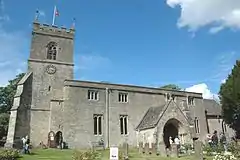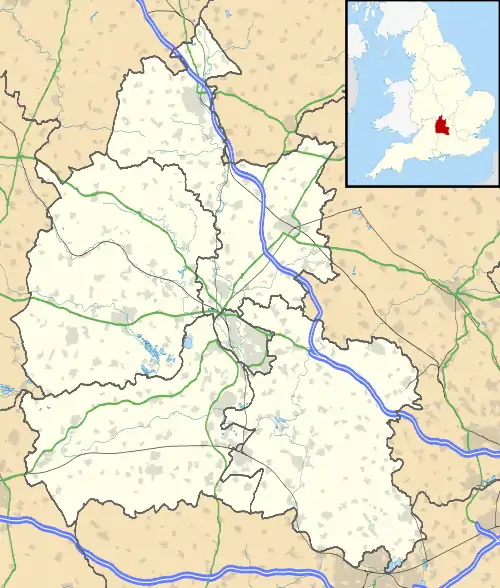Wootton, West Oxfordshire
Wootton is a village and civil parish on the River Glyme about 2 miles (3 km) north of Woodstock, Oxfordshire. In recent years the village is sometimes referred to as Wootton-by-Woodstock to distinguish it from Wootton, Vale of White Horse. [lower-alpha 1] The 2011 Census recorded the parish's population as 569.[1]
| Wootton | |
|---|---|
 St. Mary's parish church | |
 Wootton Location within Oxfordshire | |
| Population | 569 (2011 Census) |
| OS grid reference | SP4319 |
| Civil parish |
|
| District | |
| Shire county | |
| Region | |
| Country | England |
| Sovereign state | United Kingdom |
| Post town | Woodstock |
| Postcode district | OX20 |
| Dialling code | 01993 |
| Police | Thames Valley |
| Fire | Oxfordshire |
| Ambulance | South Central |
| UK Parliament | |
| Website | Wootton by Woodstock |
Overview
The village and parish are best known for:
- The steep climb from the River Glyme – 83.4m to St. Mary's parish church – 105.7m.[lower-alpha 2]
- St. Mary's parish church; a Grade II* listed building.
- Hordley House; a Grade II* listed building.[2]
- Sheep's Banks SSSI ( Holly Bank ).[3]
- Priority habitat lowland fens beside the River Glyme and River Dorn.[4]
- Akeman Street Roman road.[lower-alpha 3]
- Oxfordshire Way – long-distance footpath.[lower-alpha 4]
- Local amenities include The Village Shop and the Killingworth Castle Inn.
Name
Name history
The name was recorded as " Optone " in the Domesday Book of 1086 A.D.[5]
Survey of English Place-Names:[6]
Toponym ( Wudutune )
The name element wudu is from Old English wudu ( " wood " ).[lower-alpha 5]
The name element tune is from Old English tun ( " a village or town " ).[lower-alpha 6]
The toponym might be:
- Village in a wood
- Settlement in a wooded enclosure
Toponym ( Optone )
The name element ' Op ' may be from Old English hōp ( " valley " ).[lower-alpha 7] [lower-alpha 8]
Natural England maps
Maps showing Access, Designations and other criteria from Natural England:[lower-alpha 9]
- MAGiC MaP : Wootton by Woodstock – Parish boundary.[7]
- MAGiC MaP : Wootton – Spot height 83.4m – River Glyme.[8]
- MAGiC MaP : Wootton – Spot height 105.7m – St Marys Church.[9] [lower-alpha 10]
- MAGiC MaP : Wootton – Sheep's Banks SSSI.[3]
- MAGiC MaP : River Glyme – River Dorn ( confluence ).[4]
- MAGiC MaP : Wootton – Scheduled Monuments.[10]
- MAGiC MaP : Hordley House – Listed Building.[2]
Parish boundary
The parish is bounded to the west partly by the River Glyme, to the north partly by a stream that joins the River Dorn, to the south-east by the course of Akeman Street Roman road, to the south-west by the pale of Blenheim Great Park and on other sides by field boundaries. It includes two deserted medieval villages: Dornford on the River Dorn, and Hordley on the River Glyme just downstream of the confluence of the Dorn and Glyme.[11]
Parish church
The earliest parts of the Church of England parish church of Saint Mary are the nave, north aisle and lower part of the tower, all of which date from the first half of the 13th century,[12] and the south porch, which is Early English.[13] In the 14th century the chancel and chancel arch were rebuilt and most of the windows in the building were replaced, all in a Decorated Gothic style.[12] The upper part of the bell tower was added in the 15th century and the clerestory was added to the nave in the 16th century, each in a Perpendicular Gothic style.[12]
The tower has a ring of six bells. Edward Hemins of Bicester[14] cast the third, fourth and fifth bells in 1732[15] and the tenor bell in 1739.[15] Abel Rudhall of Gloucester[14] cast the second bell in 1749[15] and Mears & Stainbank of the Whitechapel Bell Foundry[14] cast the present treble bell in 1923.[15] St. Mary's also has a Sanctus bell that Thomas Rudhall cast in 1778.[15] The parish is now part of the benefice of Wootton with Glympton and Kiddington.[16]
Economic and social history
Early history
The Domesday Book of 1086 records Wootton as the court of the hundred of Wootton. At the time of the Hundred Rolls in 1279 Hordley was recorded as having 19 households and 150 acres (61 ha) of land.[17] By the early part of the 16th century this had declined to only five (adult) residents.[17] The Gregory family had converted most of the farmland from arable to pasture[17] which would have done much to reduce the village population.
Hordley house
The house at Hordley Farm, about 2⁄5 mile (1 km) southeast of Wootton, was built for the Gregory family[17] in about 1500.[18] It is arranged around three and a half sides of a quadrangle, possibly following the plan of an earlier medieval house on the same site.[17] The kitchen fireplace and two of the doorways have four-centred arches that date from about 1500, and the north wing has two square-headed windows from the later 16th century.[18] The ground-floor rooms have some 17th-century panelling.[18] In 1750 the house was remodelled and a gazebo was built in the garden.[18]
Village school
In 1787 the Rev. Charles Parrott, sometime vicar of Saham Toney in Norfolk, died leaving a bequest for a school to be founded and run in Wootton.[12] Early in the 19th century further schools were added in Wootton, including one run by the rector.[12] In 1836 a new building was completed to merge all education in the village into one school.[12] The Rector, Rev. L.C. Lee, paid towards the cost of the site and gave capital and the income from several cottages to fund the new school.[12] In 1942 it was reorganised as a junior school.[12] It is now Wootton-by-Woodstock Church of England Primary School.[19]
Recent history
Wootton had two public houses until 2008, when the King's Head closed.[20]
Natural history
Sheep's Banks SSSI
Sheep's Bank SSSI[lower-alpha 11] is an isolated fragment of species-rich grassland situated in an area now largely converted to arable and re-seeded pasture. The site represents the eastern-most example of traditionally managed Cotswold grassland, falling mid-way between the Jurassic limestone grasslands of Gloucestershire to the west and Northamptonshire to the east.[21]
Lowland fens
There are two areas of lowland fens that are designated as "Priority Habitat Inventory" by Natural England.[lower-alpha 12] The largest of these is near the confluence of the River Glyme and River Dorn. [lower-alpha 13]
Amenities
The village has one public house, the Killingworth Castle Inn, which was built in 1637. It is now a gastropub that has won a Michelin Bib Gourmand and two AA rosettes.[22] Wootton also has a village store.[23]
Local place names
Killingworth Castle Inn
The toponym for Killingworth Castle might be:
- Castle in a holly hedged enclosure.
The name element Killing may be from Cornish kelin or Welsh celyn ( " holly " ).[lower-alpha 14]
The name element worth is from Old English worþ ( " enclosure " ).[lower-alpha 15]
Hobbard's Hill
Hobbard's Hill may have been the habitation of a certain Hobb called " Hobbard ".[lower-alpha 16] [lower-alpha 17]
The name element ard may be from Old Irish ard,[lower-alpha 18] or from Common Brittonic arδ.[lower-alpha 19]
References
Notes
- Wootton, Vale of White Horse was in Berkshire but was transferred to Oxfordshire in the 1974 local authority boundary changes.
- See (Contents) > Natural England maps.
- The Akeman Street Roman road crosses the River Glyme at Stratford Bridge.
- The Oxfordshire Way follows Akeman Street from Tackley to Stonesfield.
- WiKtionary : Old English < wudu >
- wood
- forest, woods
- tree
- WiKtionary : Old English < tun >
- " an enclosed piece of ground "
- " a village or town "
- WiKtionary : English < hope > Etymology 3. " From Middle English hope (“a valley”), from Old English hōp (found only in placenames)."
- See also Hopcroft's Holt – OS Grid SP 465 251
- MAGiC MaP: See Table of Contents:
- Administrative Geographies > Parish boundary.
- Designations > Scheduled Monument.
- Designations > Listed Buildings.
- Designations > Habitats > Priority Habitat Inventory - Lowland Fens
- St Marys Church – OS Grid SP 439 199
- Formerly known as Holly Bank SSSI.
- See also Ramsar Convention.
- See (Contents) > Natural England maps.
- WiKtionary : Welsh < celyn >
- " holly ".
- WiKtionary : Old English < worþ >
- " enclosure ".
- Cleveland Dialect (J.C. Atkinson). < Hob > . . ."There were many Hobs, each with a local habitation and a local name". . .(PDF page 322, actual page 262).[24]
- See Hob (folklore) > Place names > . . .Examples in Oxfordshire.
- WiKtionary : Old Irish < ard >
- " high ".
- Brittonic Language < arδ > " A height, a hill ". [25]
Citations
- "Area: Wootton (Parish): Key Figures for 2011 Census: Key Statistics". Neighbourhood Statistics. Office for National Statistics. Retrieved 7 August 2015.
- "MAGiC MaP : Hordley House". Natural England – Magic in the Cloud.
- "MAGiC MaP : Wootton – Sheep's Banks SSSI". Natural England – Magic in the Cloud.
- "MAGiC MaP : River Glyme – River Dorn". Natural England – Magic in the Cloud.
- *"WOOTTON". Open Domesday. Retrieved 2 May 2023.
-
- "Survey of English Place-Names: Wootton". University of Nottingham. Retrieved 2 May 2023.
- "MAGiC MaP : Wootton – Parish boundary". Natural England – Magic in the Cloud.
- "MAGiC MaP : Wootton – River Glyme". Natural England – Magic in the Cloud.
- "MAGiC MaP : Wootton – St Marys Church". Natural England – Magic in the Cloud.
- "MAGiC MaP : Wootton – Scheduled Monuments". Natural England – Magic in the Cloud.
- Emery 1974, pp. 120–121.
- Crossley 1983, pp. 259–285.
- Sherwood & Pevsner 1974, p. 859.
- Dovemaster (25 June 2010). "Bell Founders". Dove's Guide for Church Bell Ringers. Central Council of Church Bell Ringers. Retrieved 23 March 2011.
- Davies, Peter (6 June 2008). "Wootton S Mary". Dove's Guide for Church Bell Ringers. Central Council of Church Bell Ringers. Retrieved 23 March 2011.
- Archbishops' Council (2010). "Wootton: St. Mary, Wootton". A Church Near You. Church of England. Retrieved 23 March 2011.
- Emery 1974, p. 121.
- Sherwood & Pevsner 1974, p. 860.
- Wootton-by-Woodstock CE Aided Primary School
- King's Head closure, CAMRA
- "Sheep's Bank SSSI citation" (PDF). Sites of Special Scientific Interest. Natural England. Retrieved 2 May 2023.
- "Meet the landlords and discover more about the history of The Killingworth Castle…". Killingworth Castle Inn. Retrieved 7 August 2015.
- Wootton Stores
- Atkinson 1868, pp. 262–263.
- James 2019, p. 18.
Sources and further reading
- James, Alan G. (2019). The Brittonic Language in the Old North, A Guide to the Place-Name Evidence, Volume 2 (PDF). Retrieved 1 May 2023.
{{cite book}}:|website=ignored (help)
- Crossley, Alan; Baggs, A. P.; Colvin, Christina; Colvin, H. M.; Cooper, Janet; Day, C. J.; Selwyn, Nesta; Tomkinson, A. (1983). A History of the County of Oxford. Victoria County History. Vol. 11: Wootton Hundred (northern part). London: Oxford University Press for the Institute of Historical Research. pp. 259–285. ISBN 978-0-19722-758-9.
- Emery, Frank (1974). The Oxfordshire Landscape. The Making of the English Landscape. London: Hodder & Stoughton. pp. 54, 56, 120, 121, 220. ISBN 0-340-04301-6.
- Ponsonby, Charles (1968). Wootton: The Anatomy of an Oxfordshire Village, 1945–1968. Woodstock: privately published.
- Sherwood, Jennifer; Pevsner, Nikolaus (1974). Oxfordshire. The Buildings of England. Harmondsworth: Penguin Books. pp. 859–860. ISBN 0-14-071045-0.
- Atkinson, John Christopher (1868). A Glossary of the Cleveland Dialect (1st ed.). London, J.R. Smith. Retrieved 2 April 2023.
